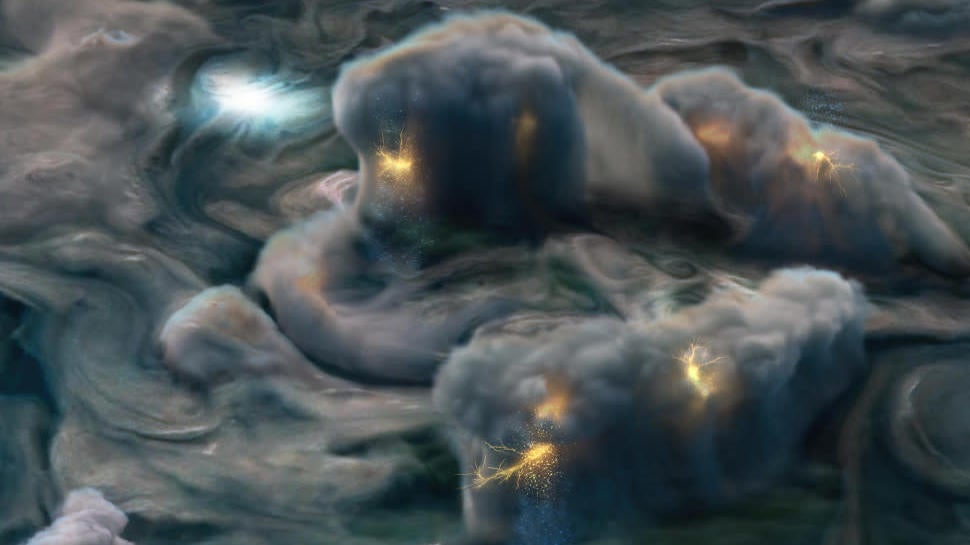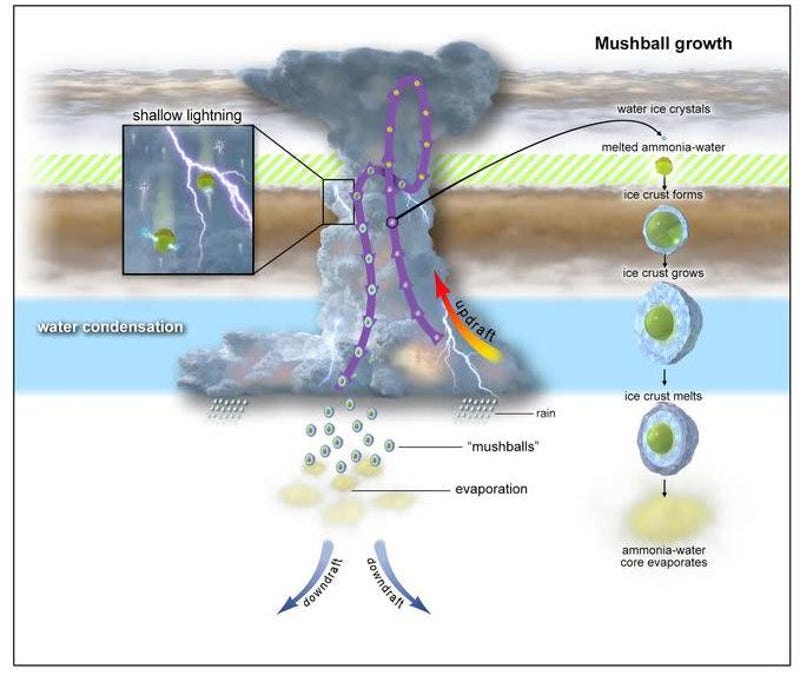George Dvorsky

Image: NASA/JPL-Caltech/SwRI/MSSS/Gerald Eichstädt
Lightning and hailstones exist on Jupiter, but they’re of a very different sort than the ones we’re familiar with on Earth, as new research suggests.
Shallow lightning on Jupiter doesn’t originate from watery clouds like on Earth but instead from clouds packed with both water and ammonia, according to new research published this week in Nature.
In a related study, published in the Journal of Geophysical Research: Planets, scientists show how these same thunderstorms are capable of producing unexpected weather in the form of hailstones, or “mushballs,” in the parlance of the researchers. These slushy orbs fall into the bowels of the gas giant, delivering ammonia to its deeper layers.
Planetary scientists have known about lightning bolts on Jupiter for decades, figuring they were caused by similar conditions on Earth, that is, forming from water clouds and at temperatures near the freezing point. For this to work, however, these storms would have to form at altitudes reaching 28 to 40 miles (45 to 65 kilometers) below Jupiter’s cloud tops. Trouble is, observations made by NASA’s Juno spacecraft pointed to the presence of smaller and shallower flashes, which appeared considerably higher in Jupiter’s atmosphere.
In the new Nature study, planetary scientist Heidi Becker from the California Institute of Technology, along with colleagues, present a plausible explanation for this apparent inconsistency: Storms at deeper atmospheric layers toss water-ice crystals up into the higher layers, some 16 miles (25 km) above the gas giant’s water clouds. The ice crystals then come into contact with ammonia at this higher altitude, resulting in an ammonia-water mixture. At this level, temperatures reach -126 degrees Fahrenheit (-88 degrees Celsius), but the ammonia melts the incoming ice.
“At these altitudes, the ammonia acts like an antifreeze, lowering the melting point of water ice and allowing the formation of a cloud with ammonia-water liquid,” explained Becker in a NASA Jet Propulsion Laboratory press release. “In this new state, falling droplets of ammonia-water liquid can collide with the upgoing water-ice crystals and electrify the clouds. This was a big surprise, as ammonia-water clouds do not exist on Earth.”
Conveniently enough, this explanation appears to have solved another mystery having to do with Jupiter: uneven gaps of missing ammonia. Scientists previously figured that the absent ammonia was caused by rain, in which a wet mixture of ammonia and water precipitated down into the deeper levels. Calculations of this scenario didn’t work, however, as the hypothesized rain wouldn’t be capable of falling deep enough to match observations made by Juno’s Microwave Radiometer, which detected the depleted ammonia.

A new explanation, as described in the new Journal of Geophysical Research study, suggests scientists were on the right track. But rather than invoking rain as the cause, the new paper, also co-authored by Becker, posits a different type of precipitation: hailstones.
Referred to as “mushballs” by the researchers, these hailstones are made from water and ammonia. Similar to the way hailstones form in Earth’s atmosphere, the mushballs start as small seeds that grow in size as they’re kept aloft by violent winds. Eventually, these slushy orbs get too heavy and fall down to the deeper layers below, evaporating in the warmer temperatures.
“As it turned out, the ammonia isn’t actually missing; it is just transported down while in disguise, having cloaked itself by mixing with water,” explained Scott Bolton, a co-author of the study and Juno PI at the Southwest Research Institute in San Antonio, in the JPL press release.
Jupiter Just Sprouted a Brand New Spot
An amateur astronomer in South Africa has detected a bright new surface feature rising above the…Read more
So, in addition to showing where the missing ammonia had gone, the new theory also explains the uneven distribution of the missing ammonia in the Jovian atmosphere.
It’s so cool when one scientific discovery leads to another, which is what happened here. Some scientific endeavors might seem superfluous or indulgent, but as these two papers show, we don’t always know where they’re going to lead us.
George Dvorsky
George is a senior staff reporter at Gizmodo.
No comments:
Post a Comment